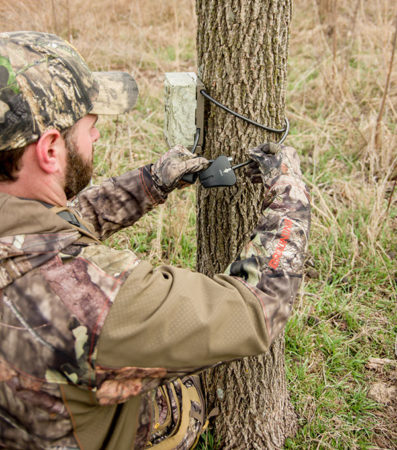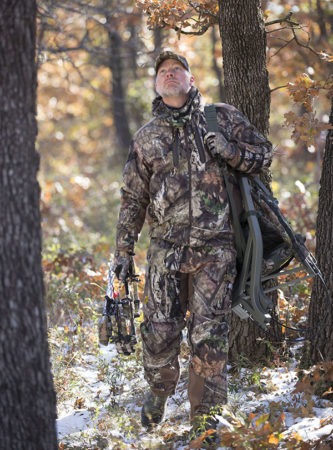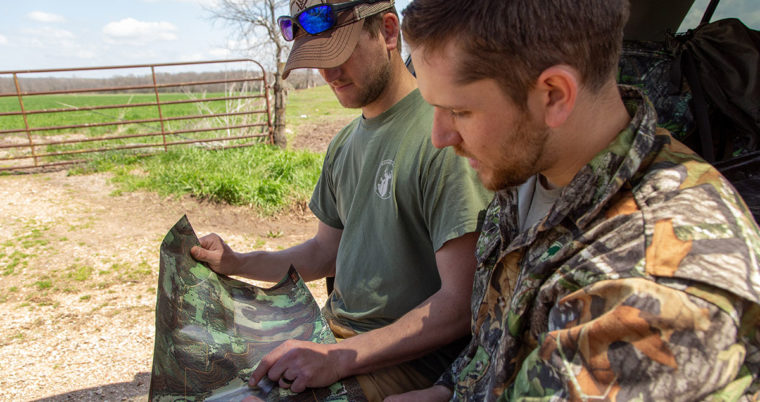You’ve probably heard all the talk recently about the decline in hunter numbers, with the U.S. Fish & Wildlife Service reporting approximately two million fewer hunters in 2016 than in 2011. One of the reasons often cited for this loss is lack of access to quality hunting land. And while there is no doubt it has gotten more difficult to access quality private hunting land, there are at least 50 million acres of state-owned land across the U.S. open to the public for deer hunting. That doesn’t include the millions of additional acres of federal land in the form of national forests, recreational areas and wildlife refuges.
Many hunters, however, are intimidated by hunting public land because they fear it’s overcrowded or they’ve heard it doesn’t provide a quality hunting experience. As both a hunter and former manager of public lands, I can tell you those beliefs are often more perception than reality. Many critics of public land hunting are basing their opinions completely on hearsay. Others had one bad experience and wrote off public land hunting as a waste of time. But there are plenty of hunters, like myself, who enjoy hunting public land for the vast opportunities and challenges it provides. To keep hunting both safe and successful on public lands, however, there are some do’s and don’ts that all public-land hunters should be aware of. Let’s take a look at a few of the most important ones, and how they can make you a safer and more successful hunter.
Do read the rules and regulations
While this probably seems like an obvious “do” to most of you, I can tell you from years of experience that it doesn’t happen nearly as often as it should. Many public hunting areas have rules that differ from private land. These differences may include season dates, legal weapons, bag limits, hunting methods, antler restrictions and methods of access. Also keep in mind that some public hunting land requires a special permit or a drawing to hunt there.
Fortunately, most state wildlife agencies do an excellent job these days of providing hunters with all the information they need — either through a printed booklet, mobile app, or on their website — to stay legal while hunting public land. Not only should you thoroughly read those rules and regulations well in advance of hunting, but I would also recommend keeping a copy handy in your vehicle or hunting pack if you should ever have a question while out in the field. Don’t be the guy who finds out you weren’t following the rules through an uncomfortable run-in with Mr. Green Jeans.
Don’t get overwhelmed

Don’t overlook running trail-cameras on public land, where permitted. While the potential for theft exists, the intel you get can outweigh the risks if you take the proper precautions.
My introduction to public land hunting came when I moved away from home to attend college in western Kentucky. Fortunately college was just a 20 minute drive from Land Between the Lakes National Recreational Area (LBL), which consists of 170,000 acres spanning parts of Kentucky and Tennessee. I had plenty of room to roam — almost too much! Hunting a tract that large can be very intimidating. It’s easy to get discouraged not knowing where to start or how you’ll ever learn such a vast expanse of wilderness. The good news is, you don’t have to learn it all, or even most of it. If you are hunting a large tract of public land, you can use a mobile app like onX Hunt to study aerial photos and topographic maps to narrow down your initial starting points to those that hold the most promise. Look for thickets and early successional habitat that would serve as good cover, and any potential terrain features that may provide an excellent site to ambush a mature buck. For a much more detailed discussion on how to scout these large blocks of public land, check out this article. Once you’ve found several promising starting points, it’s time to take the next step.
Do call the area manager or biologist
One of the most overlooked resources when it comes to hunting public lands are the folks who spend time there regularly, if not daily: the area manager, technician or biologist. Their title may vary, but most public land tracts have someone who oversees it and manages the day-to-day operations. As someone who spent 10 years of my career working in this capacity, I can tell you that area managers often carry a wealth of knowledge about the deer herd, habitat and hunting pressure where they work. He/she may not be able to tell you exactly where to go to kill a mature buck, but they can turn you on to good cover, food sources, as well as the areas that often get overlooked by other hunters. Don’t be afraid to give them a call or pay them a personal visit. Just be sure to do your homework first, and be mindful of their time.
I say to do your homework first because I still remember what it was like to be inundated by hunters looking for the best spot to hang their treestand. Don’t get me wrong, one of my favorite aspects of working on a wildlife management area was getting to interact with the hunters who used it. But I could quickly tell those who had done some scouting and were looking for additional help from those who just wanted me to tell them exactly where to go to kill a deer. Guess who got the most information from me? Not only would I answer the questions of the one who’d done his homework, but I often ended up telling him/her more than I intended. While I was also cordial to the ones looking for the easy way out, they rarely got any detailed information from me. My point is this: study the area beforehand and have some promising spots in mind. Then use the area manager to answer specific questions you may have about those spots.
One of the most overlooked resources when it comes to hunting public lands are the folks who spend time there regularly, if not daily: the area manager, technician or biologist.
Don’t focus on the obvious spots
One of the first mistakes I made when I started hunting public land was focusing on the obvious spots. These may be food plots, white oak groves or other food sources within a short walk of an access point. Chances are, if there’s lots of sign and it’s easy to access, it’s probably getting lots of hunting pressure. Regardless of how good the sign looks there, don’t waste your time.
I made this same mistake when I first started hunting LBL. There were some large agricultural fields planted to soybeans in a highly visible location where it was not unusual to see deer feeding on a late summer evening. It seemed like a great starting point to me! What I hadn’t taken into account was all the other hunters who were seeing the same thing. Days before the season, people would get in there and stomp around scouting and hanging stands. It didn’t take long for those deer to disappear. I’m sure they were still hitting those soybeans, but it was likely late at night. I didn’t start having success at LBL until I decided to get off the beaten path and start hunting places that others overlooked.
Do take plenty of time to scout
Once you’ve located several places that look promising on aerial photos and topographic maps, and you’ve discussed those spots with the area manager, it’s time to put boots on the ground. There is no replacement for in-the-field scouting. The earlier you can do this prior to the season, the better. You don’t want to walk all over your hunting area right before opening day, alerting every deer in the area to your presence. Thoroughly scout those areas that looked good on the map. Some may look even better once you see them in person, others may turn out to be a dead end. That’s why it’s important to have multiple spots picked out before heading afield.
Don’t limit yourself to one stand location

be sure to have multiple stand locations picked out well before deer season. Not only will you need stand sites to cover different wind directions, but you’ll also need a backup if someone else beats you to your first choice.
No matter how great of a spot you locate while scouting public land, never limit yourself to a single stand location. Scout and learn enough areas where you can have multiple backup stand sites, and always have a plan B, and C in mind when you head to your favorite spot. I can almost assure you that at some point someone else will be hunting the spot where you want to be, so be prepared! Even if you do manage to find a spot no one else hunts, you’ll still want options for hunting various winds and to let each stand rest so you don’t burn out a good area.
Do hunt weekdays
If your work schedule permits it, or you have vacation time to spare, try hunting your public land spots some during the week. Not only will you be less likely to run into other hunters, but some research suggests you may have better odds of seeing deer.
At the 2016 Southeast Deer Study Group Meeting, Kevyn Wiskirchen, a student at Auburn University, presented some preliminary findings from his deer research showing the GPS-collared deer he was monitoring “tended to allocate a higher percentage of their total daily movement to daylight hours on Thursdays and Fridays compared to other days of the week.” Not because Thursday and Friday are any more special to a deer than the other days of the week, but because like most public hunting land, the areas where these deer live is primarily hunted on the weekends.
Once hunters began arriving on Friday and getting out in the field, daytime deer activity rapidly dropped and continued to drop through Saturday and Sunday. The pattern of reduced daytime movement remained relatively consistent for Monday and Tuesday. By Wednesday, the deer were starting to positively respond to the lack of hunting pressure and moved more during daylight hours, and that daytime activity continued to climb until it peaked on Friday. So don’t overlook hitting your favorite public land parcel on Thursdays and Fridays this season.
Don’t mess up another person’s hunt
Another common mistake I see new public land hunters make is getting possessive of “their spots.” It’s understandable. You spend countless hours scouting for just the right place to ambush a mature buck, find the ideal tree to hang your best stand, trim up your shooting lanes (where permitted) and determine the perfect routes for getting to and from your stand. The last thing you want is someone else hunting your spot and messing things up! But the truth is, you don’t “have” any spots. Unless the agency in charge of that property assigns you to a specific area — which is unusual for public land deer hunting — then it is always first come, first served. It doesn’t matter how big the buck is you’ve been getting on your trail-camera. If someone is there first, you need to simply go someplace else. It’s the right thing to do. You wouldn’t want someone walking in on you and ruining your hunt, so don’t be the guy who does it to someone else. Give them their space and make sure you are there first next time. If you followed the previous “Do have multiple stand locations,” this shouldn’t ruin your hunt.
Final Thoughts
Hunting public land can be tough, but it can also be a very rewarding experience. Like most anything else, it’s what you make of it. If you hit the woods with a good attitude, and you follow the do’s and don’ts outlined here, it should make for a more safe and enjoyable experience. Good luck out there this season!
